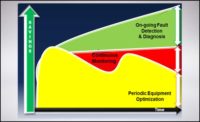While monitoring-based commissioning (MBCx) is a relatively new term in the mainstream commissioning dictionary, its practice has been part of some commissioning programs for more than 10 years.
It used to be, in the not-too-distant past, that there were four major categories of commissioning:
-
Commissioning: The third-party process for design and construction of new buildings or major renovations;
-
Recommissioning: Performing the same functional performance tests used during new construction at predetermined intervals throughout the life of the systems;
-
Retro-commissioning: The functional performance testing of existing building systems that have not previously been commissioned or retro-commissioned; and
-
On-going commissioning: A continuous program of monitoring and evaluating system performance in real-time throughout the life of the systems.
Now, mostly thanks to the USGBC’s LEED v4 revamped Energy and Atmosphere Enhanced Commissioning credit, the categories and activities have been clarified and reshuffled a bit. For the first time in the LEED program, the concept of monitoring-based commissioning has been given a name and prominent place. I put together the following diagram to illustrate how everything flows and fits together.
The LEED v4 Reference Guide for Building Design and Construction states: “Monitoring-based commissioning (MBCx) gives the building owner, operators, and the CxA a continual stream of information that helps them identify operational issues as they occur, thereby saving time, money, and energy consumption over the lifetime of the building.”
This stream of information can include trend logs used in the initial new construction commissioning or existing building retro-commissioning processes. It can also include other meters and points added specifically for the MBCx program.
For LEED v4, the ongoing commissioning plan must always include recommissioning, and additional LEED points can be earned for incorporating MBCx into the ongoing commissioning process. MBCx is relatively loosely defined and flexible regarding what the continuously monitored data comprises. It can include, but is not limited to:
- Utility energy meters;
- Energy and flow submeters; and
- BAS points
Exactly what the MBCx process does with the data is also flexible. It can be utility bill analysis, submeter trending and analysis, BAS trend graphs, BAS algorithms analyzing the data for anomalies, and/or third-party software or fault-detection diagnostics similarly analyzing the data for unexpected performance.
As illustrated in the diagram, remote monitoring and trend analysis has always been part of each flavor of commissioning to the extent applicable and customized to each situation. By giving it a name (and the USGBC assigning LEED points to it), we are recognizing how valuable the process is. It could potentially be the best bang for the commissioning buck, especially for ongoing commissioning.





